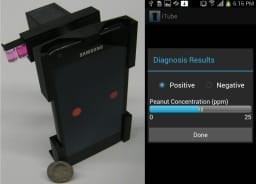
Are you allergic to peanuts and worried there might be some in that cookie? Now you can find out using a rather unlikely source: your cell phone.
A team of researchers from the UCLA Henry Samueli School of Engineering and Applied Science has developed a lightweight device called the iTube, which attaches to a common cell phone to detect allergens in food samples. The iTube attachment uses the cell phone’s built-in camera, along with an accompanying smart-phone application that runs a test with the same high level of sensitivity a laboratory would.Food allergies are an emerging public concern, affecting as many as 8 percent of young children and 2 percent of adults. Allergic reactions can be severe and even life-threatening. And while consumer-protection laws regulate the labeling of ingredients in pre-packaged foods, cross-contaminations can still occur during processing, manufacturing and transportation.
Although several products that detect allergens in foods are currently available, they are complex and require bulky equipment, making them ill-suited for use in public settings, according to the UCLA researchers.The iTube was developed to address these issues, said Aydogan Ozcan, leader of the research team and a UCLA associate professor of electrical engineering and bioengineering. Weighing less than two ounces, the attachment analyzes a test tube–based allergen-concentration test known as a colorimetric assay.








